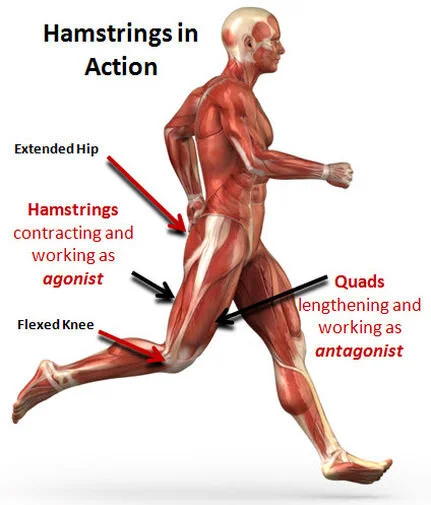Healthy Hamstrings
Our fitness level is made up of three important factors: cardio health, strength...aaaaand.....flexibility.
The last one gets left out for many athletes and those always on the go-go-go. Many times we measure our fitness by how far or fast we can run and how strong we are. As we build muscle and do repetitive motion over and over, we begin to shorten muscle fibers and tend to decrease range of motion. Making sure you have flexibility as a part of your workout plan is a great way to be sure you can stay fit and avoid injury.
The first thing I always hear when I try to introduce someone new to yoga is that they aren't flexible and can't even touch their toes.
This excuse just doesn't work. The entire reason to work on flexibility and find strength through range of motion is to do just that.
Most struggle with one of four issues, all of which are related:
Back Pain
Tight Hips (decreased range of motion)
Short Hamstrings (decreased range of motion)
Chronic Poor Posture (which can create the above three)
Our hamstrings are made up of three muscles:
Biceps Femoris
Semitendinosus
Semimembranosus
They can both flex and extend, as any muscle would, only they work opposite the largest muscle group in the body, our quadraceps. They also connect to an area in our pelvis, back side of the thigh and back side of the lower leg. As we flex the knee, our hip extend, which contracts the muscles of the hamstring, and when we extend the knee and flex our hip, the muscle lengthens like this:
Not only does the repetitive range of motion exercise of walking, running, cycling, and rowing, begin to put limitations on the muscle, incorrect form can begin to cause an anterior tilt of the pelvis, a place we don't often associate with our hamstrings finding length. However, from my perspective as a yoga teacher and functional fitness educator, I see people moving from the waist and lumbar spine, with no movement of the pelvis whatsoever. And this is why we begin to feel like our hips are the culprit.
When we fold forward, we need to think of reaching forward, rather than down. This gets rid of our need to touch our toes through sacrifice of our low back. When seated, it's important that we ALWAYS place a block, a blanket, a bolster, a SOMETHING underneath our sits bones so we can elevate the hips, giving the pelvis room to move posteriorly, thus enabling that hinging motion, rather than folding from the spine.
Something else we need to consider, and a strong reason why I'm personally not an advocate for hot yoga (warm rooms and those also where the temperature is brought up by the ambiant and circulated heat in the room is just fine), is our genetic body type. We can stretch all day long in the hottest room possible, but if you have a muscle that is a certain length, once you hit it, you are only causing damage, not helping improve flexibility.
Think of your muscles, especially your hammies, like a rubber band. You can stretch a rubber band over and over but it is always going to return to the original length. If you heat it up, it will definitely stretch further, but the moment it cools again, you have also weakened it and it becomes more easily broken. Instead think of changing the way you hold the rubber band, for instance, you could create more length by simply straightening out the fingers holding the rubber band and reach farther.
When we move to open up our hamstrings, we need to focus more on the space where the hamstrings connect to the pelvis, and the way we move through our hip, with that hinging sensation. Bringing our awareness most importantly on the posterior tilt and lengthening the spine, rather than straightening the knees and reaching the toes is the key to opening things up and finding progress. Holding stretches that focus on this type of movement which assist in the release of the myofacia, or soft tissue, where our muscles connect and our joints move from is the idea behind Yin Yoga and truly the ONLY way to become MORE flexible that you already are. However, if you are tight from sitting all day, are an athlete or are prone to genetically shorter hamstrings, there's still hope for you. All you have to do is make time to incorporate a few poses a day.
We want to always hold poses for at least 30 seconds, or it is like we didn't even stretch. To start to really open up that soft tissue and see changes in your range of motion and flexibility you will need to hold the poses for 2-5 minutes. Take your time, be patient and work your way up to that.
Below is a list of poses that are fantastic for releasing the hamstrings by focusing on the pelvis and hips. If you also concentrate on the posterior tilt discussed above, while paying attention to where you hinge from (always at the hips!) and the extension/flexion motions that occur, a mindful practice will help you relax into the breath, enabling results you can feel all over. Yoga classes are a great place to start so you can get adjustments and feedback on form, but Instagram and online videos are a great alternative too.
Yoga Pose List:
• Cobbler’s Pose
• Cow Faced Pose
• Standing Forward Bend
• Heron Pose Modified
• Standing Straddle Forward Fold
• Seated Forward Fold
• Seated Straddle Forward Fold
• Pigeon
• Pyramid Pose
• Lizard
• Downward Dog
• Reclined Hamstring Stretch
• Figure 4 Stretch/Figure 4 Twist
Here's also a quick demo video for you on a pose that can strengthen your hamstrings. Any of the above poses would be excellent as a counter maneuver to this dynamic hamstring-targeted bridge.




